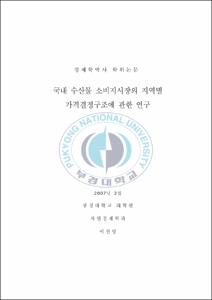국내 수산물 소비지시장의 지역별 가격결정구조에 관한 연구
- Alternative Title
- A Study on Regional Pricing Structure of Fishery Market at the Consumers Sector in Korea
- Abstract
- This paper analyses pricing structure at the distribution phase and regional areas of main fresh fishes with Vector Error Correction Model(VECM). In this study, we use the data of wholesale and retail market price of mackerel, hairtail, squid at Seoul, Busan, Daegu, Kwangju, and Daejeon in the period from January 1996 to September 2006. In order to estimate the relative efficiency of regional wholesale and retail market, we use many input-output variables from the data of 6,318 wholesale businesses and 21,036 retail businesses.
We use several empirical methods in this paper. To find out the stability of each pricing variables, we use ADF(Augmented Dickey-Fuller) unit root test. To determine the number of long-run equilibrium relationships, we apply the Johansen cointegration test. By using the VECM, we describe the long-run and short-run dynamics of price change demonstrates. By doing the Data Envelopment Analysis(DEA; CRS model, VRS model) model, we evaluate relative efficiency of regional wholesale and retail business.
The main findings of the study may be summarized as follows;
Firstly, regarding the pricing structure of the regional wholesale market, Seoul Central Wholesale Market is stronger relative to other regions for the connection role of collection-distribution in case of the small quantity and dispersed distribution. Therefore, as we expect that Seoul plays a leading role in the pricing structure, we can conclude that the function of Seoul Central Wholesale Market in two goods, hairtail and squid is stronger comparing to other cities. And Busan, which has the biggest output of mackerel, hairtail, and squid, plays a leading role.
Secondly, the regional price information itself has stronger power influence on the pricing structure of the regional retail market than from that of Seoul and other regions which have high output ratios. And we also find that three regions(Daegu, Kwangju, and Daejeon) show a higher reaction from the price information of adjacent areas. We can conclude that this result comes from real efforts in order to reduce the distribution cost such as decreasing a distribution time from consumers through retail market, keeping marine products fresh and improving facilities.
Thirdly, on the assumption that price information of the efficiently operated marine products wholesale and retail markets plays a leading role, the results from the regional efficiency analysis about the marine products wholesale and retail markets by using the DEA(Data Envelopment Analysis) model are as follows; as we expect that Seoul plays a leading role in the price information of regional consumers wholesale and retail markets, she is the first in marine products wholesale markets, and the second in retail markets from the mean value for overall technical efficiency among the sixteen cities and provinces. Busan is the second in wholesale markets and the first in retail markets respectively. These two regions have higher means value comparing to the other regions. Finally, we can draw the conclusion that these two regions(Seoul and Busan), which have efficient operations relatively to others play leading roles in the price information of pricing structure for marine products.
- Issued Date
- 2007
- Awarded Date
- 2007. 2
- Type
- Dissertation
- Keyword
- Regional Pricing Structure Wholesale and Retail Market Price Information Vector Error Correction Model Data Envelopment Analysis
- Publisher
- 부경대학교 대학원
- Alternative Author(s)
- Lee, Sun-Young
- Affiliation
- 부경대학교 대학원
- Department
- 대학원 자원경제학과
- Advisor
- 유동운
- Table Of Contents
- 제Ⅰ장 서론 = 1
제1절 연구의 필요성 및 목적 = 1
제2절 연구범위 및 방법 = 2
제Ⅱ장 선행연구 = 4
제1절 가격결정구조 분석의 선행연구 = 4
제2절 효율성 분석의 선행연구 = 12
제Ⅲ장 주요 선어류의 생산ㆍ유통구조와 수산물 도소매업의 현황 = 21
제1절 주요 선어류의 생산ㆍ유통구조 = 21
1. 고등어의 생산ㆍ유통구조 = 21
1) 생산구조 = 21
2) 유통구조 = 23
2. 갈치의 생산ㆍ유통구조 = 26
1) 생산구조 = 26
2) 유통구조 = 28
3. 오징어의 생산ㆍ유통구조 = 31
1) 생산구조 = 31
2) 유통구조 = 33
제2절 수산물 도소매업의 현황 = 36
1. 수산물 도소매업의 산업분류 = 36
2. 수산물 도소매업의 현황 및 추이 = 36
1) 사업체수 기준 현황 및 추이 = 36
2) 종사자수 기준 현황 및 추이 = 39
제Ⅳ장 가설설정 및 분석기법 = 42
제1절 가설설정 = 42
제2절 분석자료 = 47
제3절 분석기법 = 51
1. 단위근 검정과 공적분 검정 = 51
1) 단위근 검정(Unit Root Test)-ADF(Augmented Dickey-Fuller) = 52
2) 공적분 검정(Cointegration Test)-Johansen 공적분 검정법 = 56
2. 인과관계 분석 = 58
1) Granger‘s Causality 분석 = 59
2) 벡터자기회귀분석(VAR; Vector Auto Regression) = 61
3) 벡터오차수정모형(VECM; Vector Error Correction Model) = 63
3 . 효율성 분석기법-DEA(Data Envelopment Analysis)모형 = 64
제Ⅴ장 분석결과 = 71
제1절 단위근 검정과 공적분 검정결과 = 71
1. ADF 단위근 검정법을 이용한 각 시계열의 단위근 검정결과 = 71
1) 유통단계별 가격결정구조 분석에 있어서 각 시계열의 단위근 검정결과 = 71
2) 지역별 가격결정구조 분석에 있어서 각 시계열의 단위근 검정결과 = 73
2. Johansen 공적분 검정법을 이용한 시계열간 공적분 검정결과 = 80
1) 유통단계별 가격결정구조 분석에 있어서 시계열간의 공적분 검정결과 = 81
2) 지역별 가격결정구조 분석에 있어서 시계열간의 공적분 검정결과 = 82
3) 유통단계별, 지역별 가격결정구조 분석에 있어서 시계열간의 공적분 검정결과 = 85
3. VECM을 이용한 인과관계 분석 = 87
1) VECM을 이용한 유통단계별 가격결정구조의 분석결과 = 87
2) VECM을 이용한 지역별 소비지도매시장 가격결정구조의 분석결과 = 90
3) VECM을 이용한 지역별 소비지소매시장 가격결정구조의 분석결과 = 97
4) VECM을 이용한 유통단계별, 지역별 가격결정구조의 분석결과 = 102
4. DEA모형을 이용한 효율성 분석결과 = 117
제Ⅵ장 결론 = 121
제1절 요약 = 121
제2절 향후 연구과제 = 123
참고문헌 = 124
- Degree
- Doctor
- Files in This Item:
-
-
Download
 국내 수산물 소비지시장의 지역별 가격결정구조에 관한 연구.pdf
기타 데이터 / 1.86 MB / Adobe PDF
국내 수산물 소비지시장의 지역별 가격결정구조에 관한 연구.pdf
기타 데이터 / 1.86 MB / Adobe PDF
-
Items in Repository are protected by copyright, with all rights reserved, unless otherwise indicated.